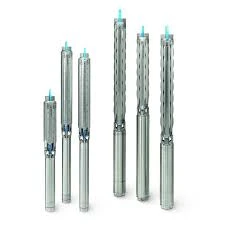Dec . 14, 2024 09:58 Back to list
Efficient Submersible Trash Pump for Heavy-Duty Wastewater Management Solutions
Understanding Submersible Trash Pumps Essential Tools for Efficient Waste Management
As urban landscapes expand and industries grow, managing wastewater and debris has become increasingly important. Among the key players in this domain are submersible trash pumps. These robust and versatile tools are engineered to efficiently handle large volumes of water mixed with solid waste, making them indispensable in various applications, including construction sites, municipal wastewater treatment, and flood recovery operations.
What is a Submersible Trash Pump?
A submersible trash pump is a type of pump designed to operate while submerged in water. Unlike conventional water pumps that are typically placed above the water level, submersible pumps are lowered into the liquid they are intended to pump. This design not only allows for more efficient pumping but also reduces the risk of cavitation, which is a common issue in surface pumps where air bubbles can form in the pump's impeller.
Submersible trash pumps are categorized as heavy-duty pumps and are specifically built to handle solid waste and debris. They often feature a rugged construction that includes high-quality materials such as stainless steel, cast iron, and high-impact thermoplastics. This allows them to withstand abrasive solids, chemicals, and varying temperatures.
Key Features and Functionality
1. Powerful Performance Submersible trash pumps are equipped with powerful motors that can move a substantial amount of water quickly. Depending on the model, these pumps can handle solids ranging from one inch to three inches in diameter, efficiently clearing out debris and preventing clogs.
2. Versatile Applications These pumps are extraordinarily versatile. They can be used in residential, commercial, and industrial settings. Common applications include draining flooded basements, emptying swimming pools, and removing water from construction sites. Municipalities also rely on them to manage stormwater and sewage in emergency situations.
3. Portability and Ease of Use Most submersible trash pumps are portable and designed for easy installation. They often come with a convenient handle and lightweight frame, which makes them easy to transport to various job sites. Additionally, these pumps are typically submersible to depths of several feet, allowing them to tackle deep-water issues without needing additional equipment.
submersible trash pump

4. Durability and Reliability Given their operational environments, submersible trash pumps are built to last. Resistance to corrosion and wear makes them suitable for long-term use. Many models are also thermally protected to prevent overheating during extended operations.
The Importance of Choosing the Right Pump
Selecting the right submersible trash pump is crucial for achieving efficient waste management. Factors to consider include the pump's flow rate, maximum head (the height to which it can pump water), and the size and type of solids it can handle. It's also essential to assess the power source—whether it’s electric or gasoline-powered—depending on the location and accessibility of power.
Maintenance for Optimal Performance
To ensure that a submersible trash pump operates efficiently and has a long service life, regular maintenance is required. This includes
- Cleaning After each use, especially when pumped liquid contains heavy debris, it’s vital to clean the pump to prevent clogs and wear. - Inspection Regularly check the motor and seals for signs of wear and tear. - Storage When not in use, store the pump in a dry place to prevent corrosion and damage from weather.
Conclusion
Submersible trash pumps are indispensable tools in modern waste management, providing solutions in both emergency situations and routine operations. Their robust design, powerful performance, and versatility make them a favorite choice across various sectors. As industries and urban areas continue to grow, the importance of efficient waste management solutions, such as submersible trash pumps, will only become more critical. By understanding their function and maintaining these tools properly, operators can ensure effective waste removal and contribute to a cleaner and safer environment.
-
Submersible Water Pump: The Efficient 'Power Pioneer' of the Underwater World
NewsJul.01,2025
-
Submersible Pond Pump: The Hidden Guardian of Water Landscape Ecology
NewsJul.01,2025
-
Stainless Well Pump: A Reliable and Durable Pumping Main Force
NewsJul.01,2025
-
Stainless Steel Submersible Pump: An Efficient and Versatile Tool for Underwater Operations
NewsJul.01,2025
-
Deep Well Submersible Pump: An Efficient 'Sucker' of Groundwater Sources
NewsJul.01,2025
-
Deep Water Well Pump: An Efficient 'Sucker' of Groundwater Sources
NewsJul.01,2025
-
 Submersible Water Pump: The Efficient 'Power Pioneer' of the Underwater WorldIn the field of hydraulic equipment, the Submersible Water Pump has become the core equipment for underwater operations and water resource transportation due to its unique design and excellent performance.Detail
Submersible Water Pump: The Efficient 'Power Pioneer' of the Underwater WorldIn the field of hydraulic equipment, the Submersible Water Pump has become the core equipment for underwater operations and water resource transportation due to its unique design and excellent performance.Detail -
 Submersible Pond Pump: The Hidden Guardian of Water Landscape EcologyIn courtyard landscapes, ecological ponds, and even small-scale water conservancy projects, there is a silent yet indispensable equipment - the Submersible Pond Pump.Detail
Submersible Pond Pump: The Hidden Guardian of Water Landscape EcologyIn courtyard landscapes, ecological ponds, and even small-scale water conservancy projects, there is a silent yet indispensable equipment - the Submersible Pond Pump.Detail -
 Stainless Well Pump: A Reliable and Durable Pumping Main ForceIn the field of water resource transportation, Stainless Well Pump has become the core equipment for various pumping scenarios with its excellent performance and reliable quality.Detail
Stainless Well Pump: A Reliable and Durable Pumping Main ForceIn the field of water resource transportation, Stainless Well Pump has become the core equipment for various pumping scenarios with its excellent performance and reliable quality.Detail
